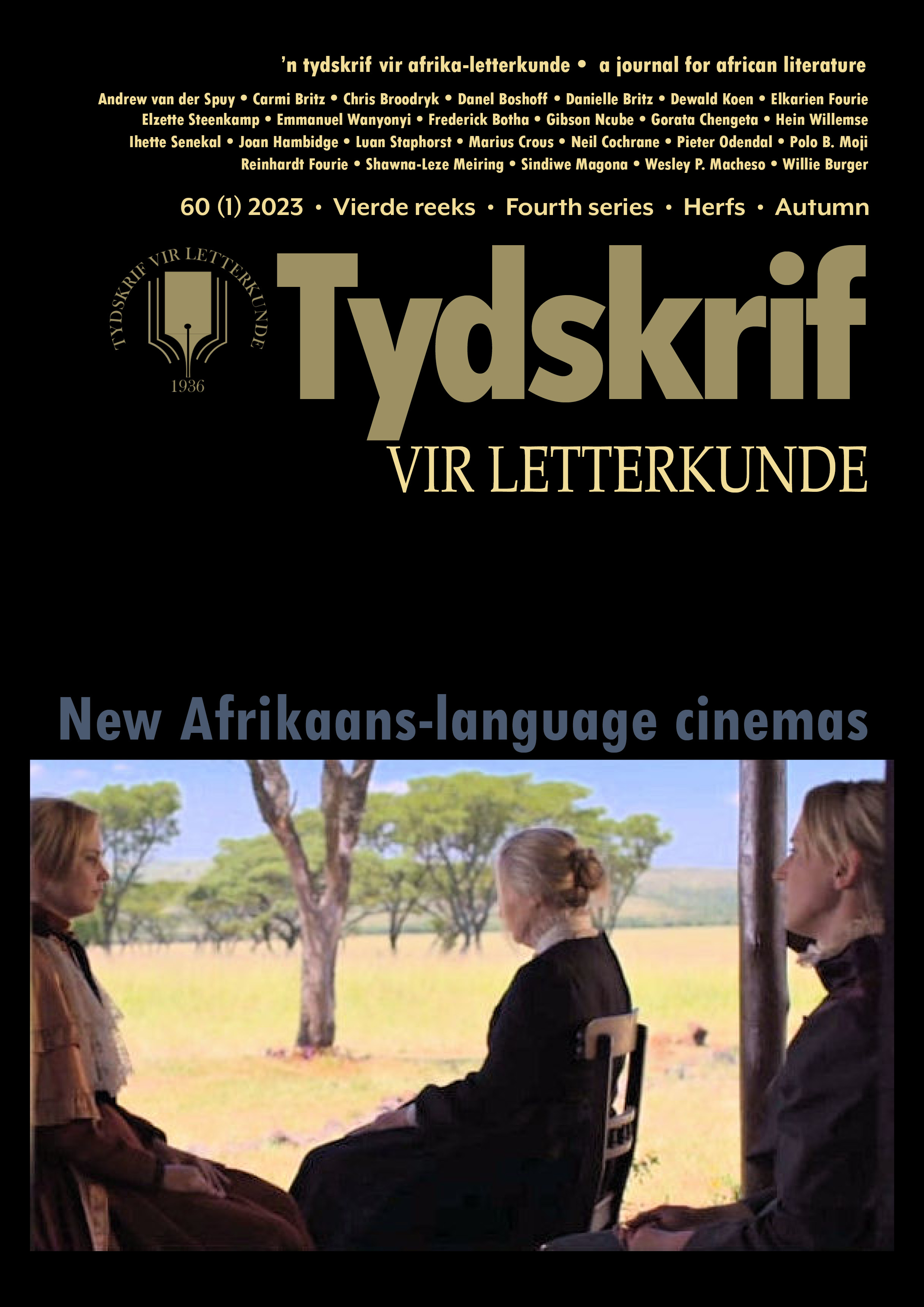La beauté lente : Recentrer le Skoonheid d’Oliver Hermanus à travers l’objectif d’un cinéma lent
DOI :
https://doi.org/10.17159/tl.v60i1.15109Mots-clés :
Skoonheid, cinéma lent, contemplation, aliénation, narration, image lenteRésumé
Le film Skoonheid d’Oliver Hermanus est souvent considéré comme une représentation des réalités queer sud-africaines et du progrès politique pendant et depuis la dissolution de l’apartheid. Par conséquent, la contribution d’Hermanus à l’esthétique de la lenteur dans Skoonheid est passée largement inaperçue dans le contexte plus large du cinéma lent. Dans cet article, j’examine comment Hermanus, par le biais des conventions du cinéma lent, incite le spectateur à contempler des questions d’une importance cruciale pour le comportement humain, mettant ainsi en évidence les qualités méditatives de Skoonheid. En m’appuyant sur le concept de minimalisme expressif d’Ira Jaffe, sur la poétique du cinéma lent d’Emre Çağlayan et sur les observations de Thomas Elsaesser sur les vertus et les exigences du cinéma lent, j’analyse les stratégies narratives et esthétiques déployées dans Skoonheid dans le cadre du cinéma lent et au-delà d’une représentation de la sexualité queer. Cette analyse révèle que Skoonheid représente un mode d’expressivité narrative et formelle distinct du cinéma lent, mais en dialogue avec lui, car il met l’accent sur la contemplation. Principalement, Hermanus trouve un moyen de témoigner de certaines des préoccupations les plus urgentes de la société contemporaine à travers l’approche contemplative du film, qui attire l’attention du spectateur sur le mystère et l’ambiguïté de l’expérience humaine. L’approche contemplative de Skoonheid s’inspire des processus et des expériences du film en matière d’aliénation, d’incommunicabilité et d’existentialisme.
Téléchargements
Références
Andrews, Grant. “The Boundaries of Desire and Intimacy in Post-apartheid South African Queer Film: Oliver Hermanus’s Skoonheid.” Image & Text vol. 31, no. 1, 2018, pp. 30–47. DOI: https://journals.co.za/doi/10.10520/EJC-106116ecae.
Bazin, Andre. What is Cinema? Vol. 1. U of California P, 2004.
Boczkowska, Kornelia. “Speeding Slowness: Neo-modern Contemplative and Sublime Cinema Aesthetics in Godfrey Reggio’s ‘Qatsi Trilogy’.” Art Inquiry vol. 18, 2016, pp. 221–53.
Bordwell, David. Narration in the Fiction Film. U of Wisconsin P, 1985.
Çağlayan, Emre. Poetics of Slow Cinema. Palgrave Macmillan, 2018.
Çağlayan, Emre. “Screening Boredom: The History and Aesthetics of Slow Cinema.” Diss. U Kent, 2014. https://kar.kent.ac.uk/43155/.
Cutting, James. E. & Ayse Candan. “Shot Durations, Shot Classes, and the Increased Pace of Popular Movies.” Projections vol. 9, no. 2, 2015, pp. 40–62. DOI: https://doi.org/10.3167/proj.2015.090204.
De Waal, Mandy. “Skoonheid—a film that confronts truths, both beautiful and ugly.” Daily Maverick. 24 Jul. 2011. https://www.dailymaverick.co.za/article/2011-07-24-skoonheid-a-film-that-confronts-truths-both-beautiful-and-ugly/.
Deleuze, Gilles. Cinema 2: The time-image. U of Minnesota P, 1989.
Doane, Mary. The Emergence of Cinematic Time: Modernity, Contingency, the Archive. Harvard U P, 2002.
Ebert, Roger. Roger Ebert’s Movie Yearbook 2007. McMeel, 2007.
Flanagan, Matthew. Slow Cinema: Temporality and Style in Contemporary Art and Experiemental Film. U of Exeter, 2012.
Ford, Hamish. Post-War Modernist Cinema and Philosophy: Confronting Negativity and Time. Palgrave Macmillan, 2012.
Goethe, Johann von. Elective Affinities, translated by Reginald Hollingdale. Penguin, 1978.
Gott, Michael. 2016. “The Slow Road to Europe: the Politics and Aesthetics of Stalled Mobility in ‘Heremakono’ and ‘Morgen’.” Slow Cinema: Traditions in World Cinema, edited by Tiago de Luca & Nuno Jorge. Edinburgh U P, 2016, pp. 299–311.
Gray, Chantelle. “The Spectre-image: A Hauntology of Skoonheid and Kanarie.” Image & Text vol. 35, no. 1, 2021, pp. 1–21. http://www.imageandtext.up.ac.za/imageandtext/article/view/242.
Grønstad, Asbjørn. “Slow Cinema and the Ethics of Duration.” Slow Cinema: Traditions in World Cinema, edited by Tiago de Luca & Nuno Jorge. Edinburgh U P, 2016, pp. 273–84.
Hermanus, Oliver. “Director’s note.” Skoonheid: Een film van Oliver Hermanus. Yumpu. 23 Feb. 2012. https://www.yumpu.com/en/document/read/19450509/skoonheid-cinemien.
Hermanus, Oliver. “Slow and Boring for Dummies.” Channel 24. 19 Aug. 2011. <https://m.channel24.co.za/Columnists/Oliver-Hermanus/Slow-and-Boring-for-Dummies-20110819>. Accessed 12 Aug. 2021.
Hermanus, Oliver & Olivier Barlet. “Oliver Hermanus: ‘It’s not a judgement of a character, it’s a portrait’.” Africine.org. 9 Jun. 2011. http://www.africine.org/entretien/oliver-hermanus-its-not-a-judgement-of-a-character-its-a-portrait/10237.
Hermanus, Oliver & Tymon Smith. “Directors chat: Oliver Hermanus.” Times Live. 5 Aug. 2011. https://www.timeslive.co.za/tshisa-live/tshisa-live/2011-08-05-directors-chat-oliver-hermanus/.
Jaffe, Ira. Slow movies: Countering the Cinema of Action. Columbia U P, 2014.
Jones, Tiffany. “Averting White Male (Ab)normality: Psychiatric Representations and Treatment of ‘Homosexuality’ in 1960s South Africa.” Journal of Southern African Studies vol. 34, no. 2, 2008, pp. 397–410. DOI: https://doi.org/10.1080/03057070802038058.
Kiss, Miklos & Steven Willemsen. Impossible Puzzle Films: A Cognitive Approach to Contemporary Complex Cinema. Edinburgh U P, 2017.
Kovács, András Bálint. Screening Modernism: European Art Cinema, 1950–1980. U of Chicago P, 2007.
Lockyer, Sharon. “Textual Analysis Methodologies.” The Sage Encyclopaedia of Qualitative Research Methods, edited by Lisa Given. Sage, 2008, pp. 865–6.
Lovatt, Philippa. “Slow Sounds: Duration, Audition and Labour in Liu Jiayin’s ‘Oxhide and Oxhide II.” Slow Cinema: Traditions in World Cinema, edited by Tiago de Luca & Nuno Jorge. Edinburgh U P, 2016, pp. 192–203.
De Luca, Tiago & Nuno Jorge. “Introduction: From Slow Cinema to Slow Cinemas.” Slow Cinema: Traditions in World Cinema, edited by Tiago de Luca & Nuno Jorge. Edinburgh U P, 2016, pp. 1–21.
Schoonover, Karl. “Wastrels of Time: Slow Cinema’s Labouring Body, the Political Spectator and the Queer.” Slow Cinema: Traditions in World Cinema, edited by Tiago de Luca & Nuno Jorge. Edinburgh U P, 2016, pp. 153–68.
Thomson, Claire. “The Slow Pulse of the Era: Carl Th. Dreyer’s Film Style.” Slow Cinema: Traditions in World Cinema, edited by Tiago de Luca & Nuno Jorge. Edinburgh U P, 2016, pp. 47–58.
Tomasulo, Frank P. & Jason Grant McKahan. “Sick Eros: The Politics of Antonioni’s Trilogy.” Projections vol. 3, no. 1, 2009, pp. 1–23. DOI: https://doi.org/10.3167/proj.2009.030102.
Warner, Rick. “Filming a miracle: Ordet, Silent Light, and the spirit of contemplative cinema.” Critical Quarterly vol. 57, no. 2, 2015, pp. 46–71. DOI: https://doi.org/10.1111/criq.12196.
Wildfeuer, Janina. Film Discourse Interpretation: Towards a New Paradigm for Multimodal Film Analysis. Routledge, 2013.
Téléchargements
Publiée
Numéro
Rubrique
Licence
(c) Copyright Tydskrif vir Letterkunde 2023

Ce travail est disponible sous licence Creative Commons Attribution - Partage dans les Mêmes Conditions 4.0 International.


 https://orcid.org/0000-0001-6465-6584
https://orcid.org/0000-0001-6465-6584


.png)